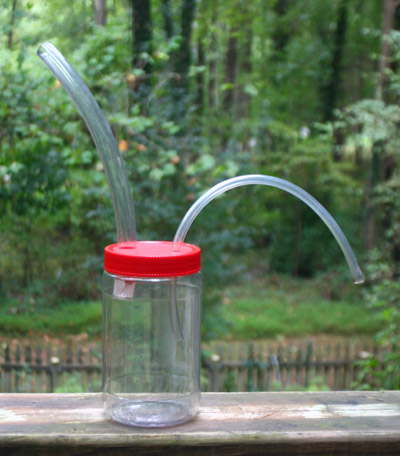After attempting a couple of other techniques that weren’t working so well, I finally broke down and did it: I made myself a pooter.
 If you are not familiar with entomology, you may have a variety of responses to this statement, including, “Congratulations – Al is a big boy now!” and, “Isn’t that a slang term for female genitalia?” But no, that’s cooter… actually, it probably could be either, since it seems anything can be a slang term for female genitalia if you say it right. Doesn’t matter, because that’s not what I’m talking about, and anyway, I wouldn’t make one. That’s… just…
If you are not familiar with entomology, you may have a variety of responses to this statement, including, “Congratulations – Al is a big boy now!” and, “Isn’t that a slang term for female genitalia?” But no, that’s cooter… actually, it probably could be either, since it seems anything can be a slang term for female genitalia if you say it right. Doesn’t matter, because that’s not what I’m talking about, and anyway, I wouldn’t make one. That’s… just…
A pooter, at times also called an aspirator if you want to be boring while being just as vague, is a simple bug collecting device, that works pretty much like a shop vac. Two tubes, one jar (let it go.) One tube goes into your mouth, with the other end feeding into the jar. The other tube comes out of the jar and is aimed at the arthropod you wish to collect. Bring that tube close to the subject, give a quick inhalation, and zip! The bug ends up in the jar.
The crucial bit of this is the bit of gauze or thin fabric over the opposite end of the mouth tube, the end within the jar – this acts as a filter so you don’t suck any bugs into your mouth. It may also slow down something nasty produced by the bug when it gets annoyed at being abducted, but don’t count on this – stink bugs and bombardier beetles should probably be avoided.
 It works amazingly well, and takes very little inhalation to snag the target. I had used a larger mouth tube to be able to draw an insect all the way up the capture tube easily, but this really doesn’t seem necessary. I would recommend, however, ensuring that it’s easy to distinguish which tube is which, lest you put the wrong one in your mouth and a) mash your target bug against the gauze filter and think that you missed it, and/or b) end up inhaling a previous capture. Also, per the advice of someone else, the jar should be clear but not glass, just for safety’s sake.
It works amazingly well, and takes very little inhalation to snag the target. I had used a larger mouth tube to be able to draw an insect all the way up the capture tube easily, but this really doesn’t seem necessary. I would recommend, however, ensuring that it’s easy to distinguish which tube is which, lest you put the wrong one in your mouth and a) mash your target bug against the gauze filter and think that you missed it, and/or b) end up inhaling a previous capture. Also, per the advice of someone else, the jar should be clear but not glass, just for safety’s sake.
There is no ‘valve’ on the capture tube to prevent insects from heading back up it, and none really necessary. Provided that the tube extends down into the jar a few centimeters, any flying insect that gets captured will almost never find the exit; they tend to stick to the sides, especially where they can see daylight, and not investigate something poking down from the ‘roof.’ The same design is used for various fly traps and it works quite well.
I even made a smaller version, nothing but a polyethylene pipette with the end of the bulb cut off and a bit of gauze inserted in the middle of the tube, kind of a glorified straw – this is for capturing flying specimens inside the big jar and transferring them to something else. Very gentle inhalation is used and maintained, which keeps the arthropod held against the gauze trap, and once the end in inserted into the new holding facility (say, a small terrarium for photography,) a slight exhalation expels the insect back out of the tube.
For bigger specimens, I just scoop them into a film can, and if I find something that won’t fit in a film can, those are collected at gunpoint.
Now, I made the pooter for a specific reason, and as I was working on the post, it paid off. So another is coming very soon, as soon as I get all the bits together. For now, something that doesn’t suck, in whatever sense of the word: at least one mantis, and possibly two, has moved back into the Japanese maple tree, and this one at least is showing signs of an impending egg sac, so I’m checking for progress periodically. We’ll see what happens.





















































